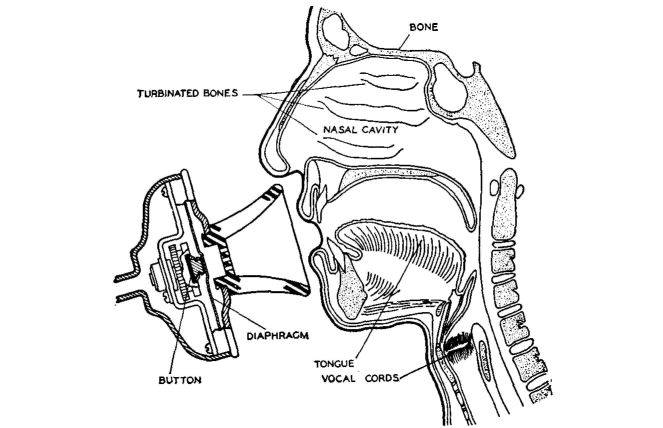| Electrical Communication is a free textbook on the basics of communication technology. See the editorial for more information.... |

|

Home  Fundamentals of Acoustics Fundamentals of Acoustics  The Production of Speech Sounds The Production of Speech Sounds |
|||






|
|||
The Production of Speech SoundsAll sounds of speech do not originate in the same manner. If the source of speech sounds is taken as a basic of classification, there are three different types; (1) those speech sounds produced by the vocal cords and the resonating air cavities of the head, (2) those produced by passing the air through small openings or over sharp edges in the mouth (for example, the teeth), and (3) the sounds produced by a combination of (1) and (2). The human vocal organs consist of three principal parts. The first of these is the lungs and respiratory muscles, which provide a flow of air. The second is the larynx, containing the vocal cords as shown in Fig. 6, which produce the modulation of the air stream. The third part consists of the throat, mouth, and nasal cavities, which vary the harmonic content of the sound waves set up by the vocal cords, and which also originate certain sounds as mentioned in (2) of the preceding paragraph.
The vocal cords act as the generator for most speech sounds. They are capable of varying the shape and the width of the narrow slit which they form across the air passage.19 In this way they control the pitch of the fundamental sound emitted. Under the influence of the stream of air passing between them from the lungs, these cords vibrate, producing sound waves. These waves are rich in harmonics, or overtones, and pass up into the resonant chambers provided by the throat, mouth, and nasal cavities. These are illustrated by Fig. 6. The size and shape of the mouth are varied by the speaker largely through movements of the lips and tongue, and certain resonant chambers are accordingly controlled. Through this action the waves from the vocal cords are given the characteristics of speech. The vocal cords, therefore, produce basic sounds which carry most of the energy of the voice waves but do not give speech its intelligibility. This is largely provided by the throat, mouth, and nasal cavities. This explanation is substantiated by the artificial larynx. Through a surgical operation necessitated by disease, persons have had their larynges removed and have been left essentially speechless. The Bell Telephone Laboratories working in conjunction with surgeons devised an artificial larynx20 which makes speech again possible for these unfortunate people. For engineering purposes,21 it is considered that there are certain fundamental speech sounds in spoken English. These are: (1) the pure vowels, (2) the diphthongs, (3) the transitionals, (4) the semivowels, (5) the fricative consonants, and (6) the stop consonants.
|
|||
Home  Fundamentals of Acoustics Fundamentals of Acoustics  The Production of Speech Sounds The Production of Speech Sounds |
|||
Last Update: 2011-05-30


